MITSUBISHI PAJERO IV 2011 Repair Manual
Manufacturer: MITSUBISHI, Model Year: 2011, Model line: PAJERO IV, Model: MITSUBISHI PAJERO IV 2011Pages: 377, PDF Size: 29.43 MB
Page 61 of 377
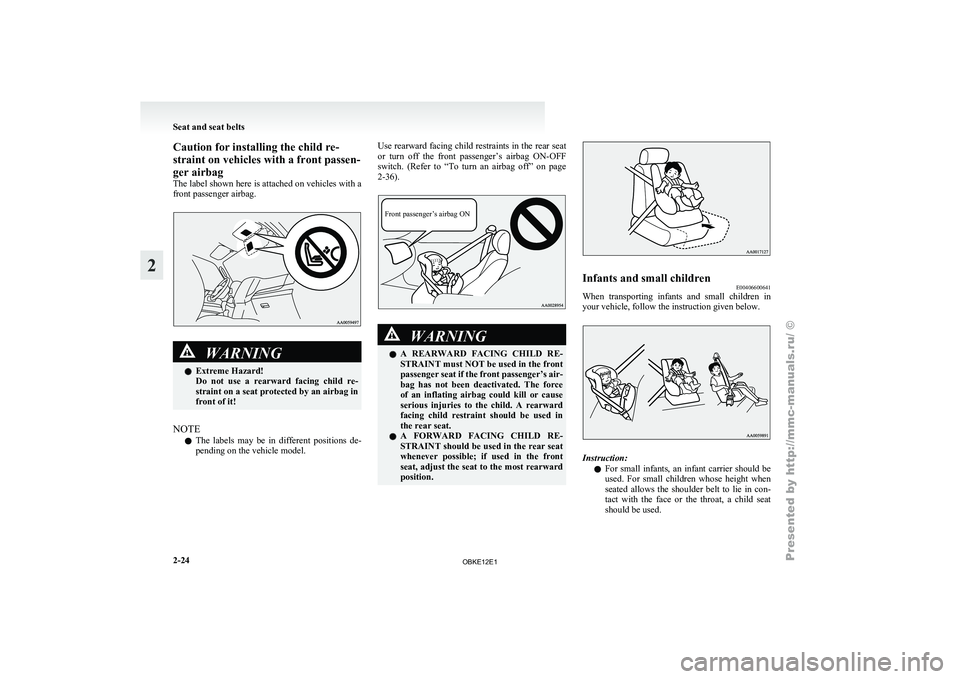
Caution for installing the child re-
straint on vehicles with a front passen-
ger airbag
The label
shown
here is attached on vehicles with a
front passenger airbag. WARNING
l Extreme Hazard!
Do not
use
a rearward facing child re-
straint on a seat protected by an airbag in
front of it!
NOTE l The
labels may
be in different positions de-
pending on the vehicle model. Use rearward facing child restraints in the rear seat
or
turn
off
the front passenger’s airbag ON-OFF
switch. (Refer to “To turn an airbag off” on page
2-36).
Front passenger’s airbag ON WARNING
l A REARWARD
FACING
CHILD RE-
STRAINT must NOT be used in the front
passenger seat if the front passenger’s air-
bag has not been deactivated. The force
of an inflating airbag could kill or cause
serious injuries to the child. A rearward
facing child restraint should be used in
the rear seat.
l A FORWARD FACING CHILD RE-
STRAINT should be used in the rear seat
whenever possible; if used in the front
seat, adjust the seat to the most rearward
position. Infants and small children
E00406600641
When transporting infants and small children in
your vehicle, follow the instruction given below. Instruction:
l For small
infants,
an infant carrier should be
used. For small children whose height when
seated allows the shoulder belt to lie in con-
tact with the face or the throat, a child seat
should be used. Seat and seat belts
2-24
2
OBKE12E1
Page 62 of 377
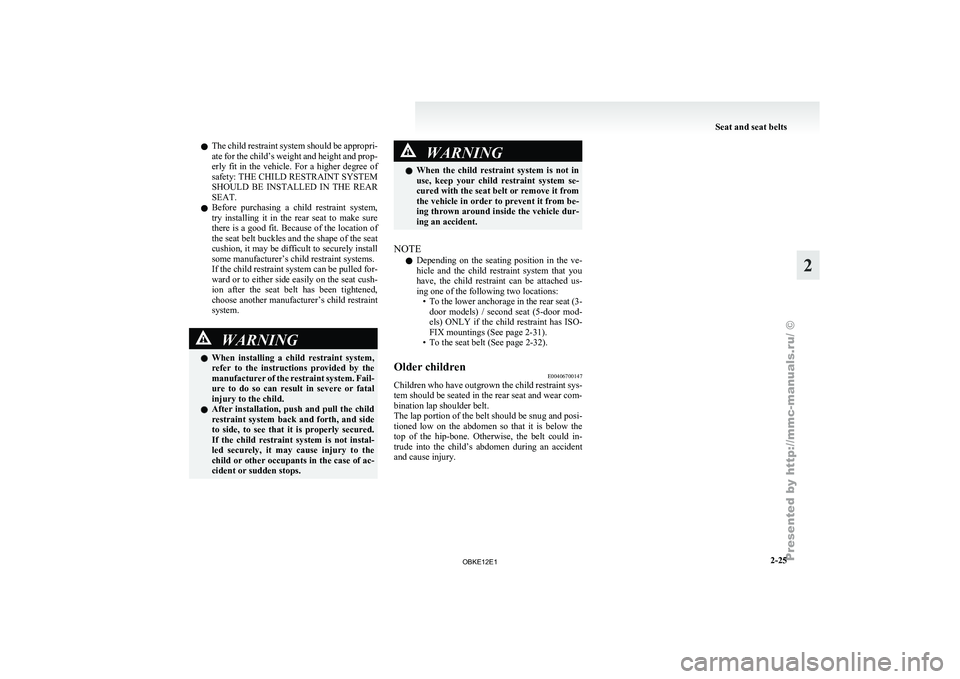
l
The child
restraint system should be appropri-
ate for the child’s weight and height and prop-
erly fit in the vehicle. For a higher degree of
safety: THE CHILD RESTRAINT SYSTEM
SHOULD BE INSTALLED IN THE REAR
SEAT.
l Before purchasing a child restraint system,
try installing it in the rear seat to make sure
there is a good fit. Because of the location of
the seat belt buckles and the shape of the seat
cushion, it may be difficult to securely install
some manufacturer’s child restraint systems.
If the child restraint system can be pulled for-
ward or to either side easily on the seat cush-
ion after the seat belt has been tightened,
choose another manufacturer’s child restraint
system. WARNING
l When installing
a
child restraint system,
refer to the instructions provided by the
manufacturer of the restraint system. Fail-
ure to do so can result in severe or fatal
injury to the child.
l After installation, push and pull the child
restraint system back and forth, and side
to side, to see that it is properly secured.
If the child restraint system is not instal-
led securely, it may cause injury to the
child or other occupants in the case of ac-
cident or sudden stops. WARNING
l When the child
restraint system is not in
use, keep your child restraint system se-
cured with the seat belt or remove it from
the vehicle in order to prevent it from be-
ing thrown around inside the vehicle dur-
ing an accident.
NOTE l Depending
on the
seating position in the ve-
hicle and the child restraint system that you
have, the child restraint can be attached us-
ing one of the following two locations: • To the lower anchorage in the rear seat (3-door models) / second seat (5-door mod-
els) ONLY if the child restraint has ISO-
FIX mountings (See page 2-31).
• To the seat belt (See page 2-32).
Older children E00406700147
Children who have outgrown the child restraint sys-
tem should be seated in the rear seat and wear com-
bination lap shoulder belt.
The lap portion of the belt should be snug and posi-
tioned low on
the abdomen so that it is below the
top of the hip-bone. Otherwise, the belt could in-
trude into the child’s abdomen during an accident
and cause injury. Seat and seat belts
2-25 2
OBKE12E1
Page 63 of 377
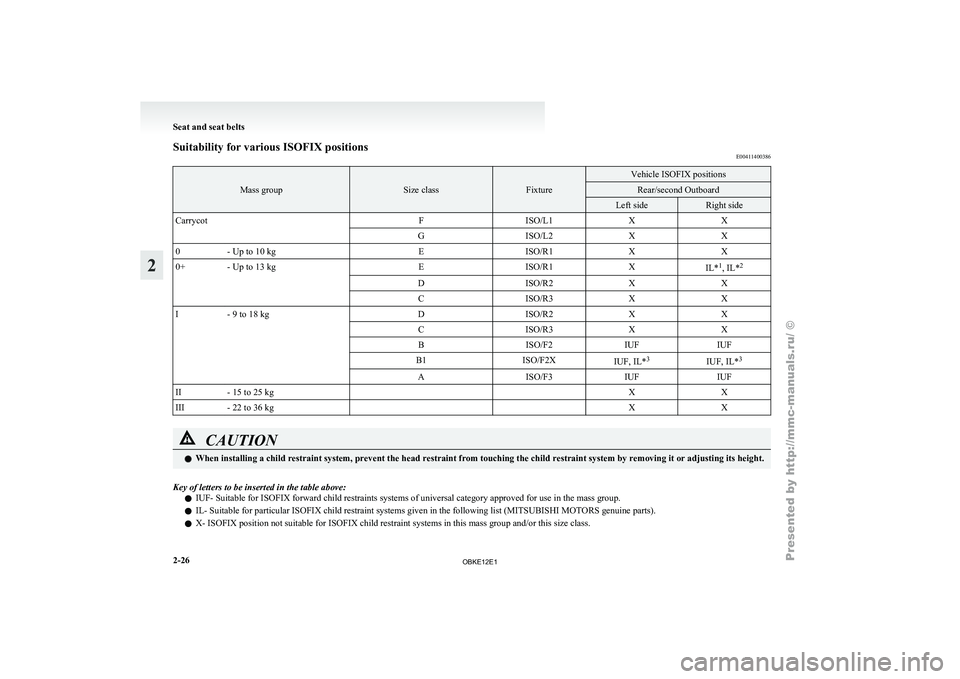
Suitability for various ISOFIX positions
E00411400386Mass group Size class Fixture Vehicle ISOFIX positions
Rear/second Outboard
Left side Right side
Carrycot FISO/L1XX
G ISO/L2XX
0 - Up to 10 kg EISO/R1XX
0+ - Up to 13 kg EISO/R1X
IL*1
, IL* 2
D ISO/R2XX
C ISO/R3XX
I - 9 to 18 kg DISO/R2XX
C ISO/R3XX
B ISO/F2IUFIUF
B1 ISO/F2X
IUF, IL*3
IUF, IL*3
A ISO/F3IUFIUF
II - 15 to 25 kg X X
III - 22 to 36 kg X XCAUTION
l
When installing a child restraint system, prevent the head restraint from touching the child restraint system by removing it or adjusting its height.
Key of letters to be inserted in the table above: l IUF- Suitable for ISOFIX forward child restraints systems of universal category approved for use in the mass group.
l IL- Suitable for particular ISOFIX child restraint systems given in the following list (
MITSUBISHI MOTORS genuine parts).
l X- ISOFIX position not suitable for ISOFIX child restraint systems in this mass group and/or this size class. Seat and seat belts
2-26
2
OBKE12E1
Page 64 of 377
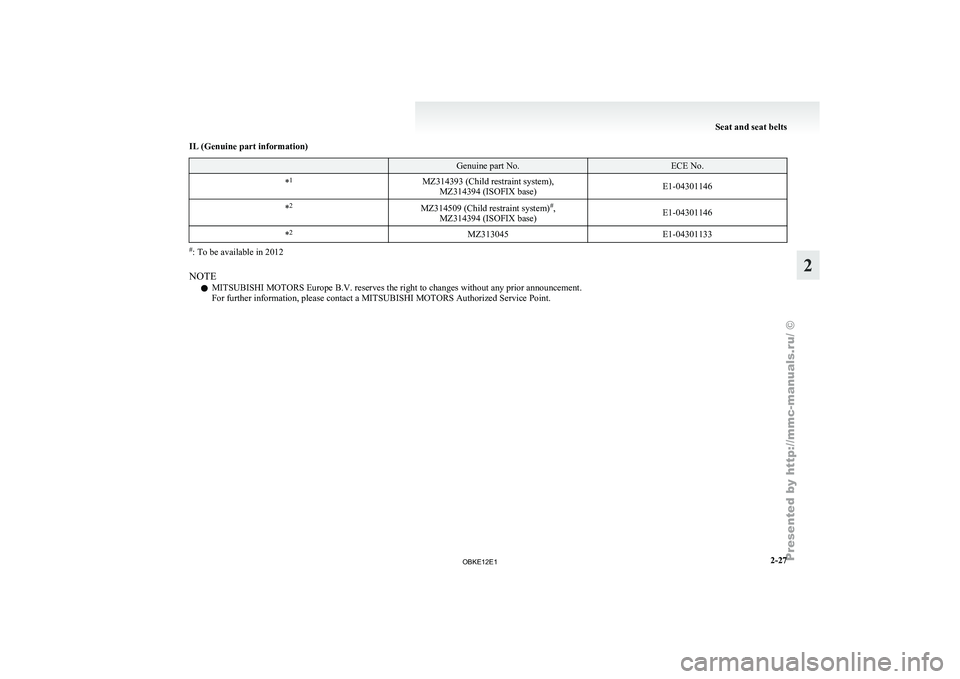
IL (Genuine part information)
Genuine part No. ECE No.
* 1
MZ314393 (Child restraint system),
MZ314394 (ISOFIX base) E1-04301146
* 2
MZ314509 (Child restraint system)#
,
MZ314394 (ISOFIX base) E1-04301146
* 2
MZ313045 E1-04301133#
: To be available in 2012
NOTE l MITSUBISHI MOTORS Europe B.V. reserves the right to changes without any prior announcement.
For further information, please contact a MITSUBISHI MOTORS
Authorized Service Point. Seat and seat belts
2-27 2
OBKE12E1
Page 65 of 377
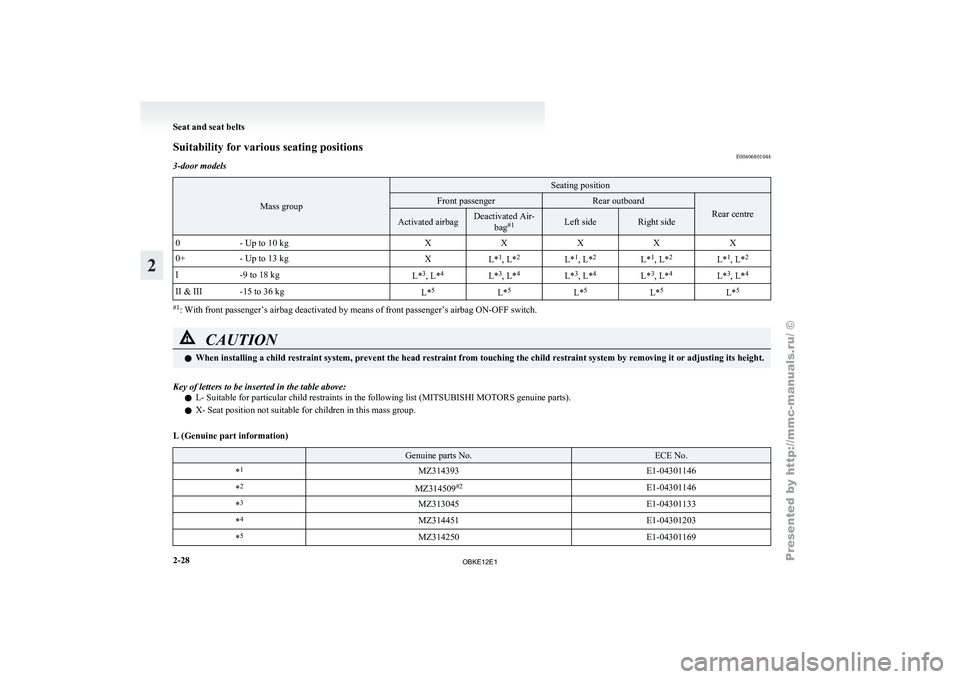
Suitability for various seating positions
E00406801044
3-door models Mass group Seating position
Front passenger Rear outboard
Rear centre
Activated airbag Deactivated Air-
bag#1 Left side Right side
0 - Up to 10 kg XXXXX
0+ - Up to 13 kg
XL*1
, L* 2
L*1
, L* 2
L*1
, L* 2
L*1
, L* 2
I -9 to 18 kg
L*3
, L* 4
L*3
, L* 4
L*3
, L* 4
L*3
, L* 4
L*3
, L* 4
II & III -15 to 36 kg L*5
L*5
L*5
L*5
L*5 #1
: With front passenger’s airbag deactivated by means of front passenger’s airbag ON-OFF switch. CAUTION
l
When installing a child restraint system, prevent the head restraint from touching the child restraint system by removing it or adjusting its height.
Key of letters to be inserted in the table above: l L- Suitable for particular child restraints in the following list (
MITSUBISHI MOTORS genuine parts).
l X- Seat position not suitable for children in this mass group.
L (Genuine part information) Genuine parts No. ECE No.
* 1
MZ314393 E1-04301146
* 2
MZ314509#2
E1-04301146
* 3
MZ313045 E1-04301133
* 4
MZ314451 E1-04301203
* 5
MZ314250 E1-04301169Seat and seat belts
2-28
2
OBKE12E1
Page 66 of 377
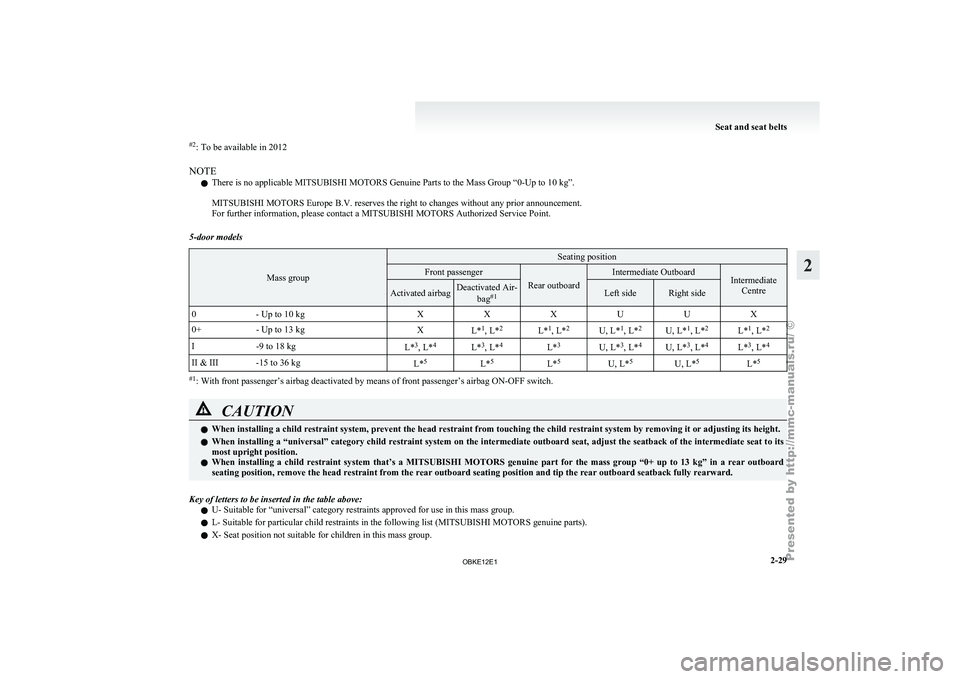
#2
: To be available in 2012
NOTE l There is no applicable MITSUBISHI MOTORS
Genuine Parts to the Mass Group “0-Up to 10 kg”.
MITSUBISHI MOTORS
Europe B.V. reserves the right to changes without any prior announcement.
For further information, please contact a MITSUBISHI MOTORS Authorized Service Point.
5-door models Mass group Seating position
Front passenger
Rear outboard Intermediate Outboard
Intermediate
Centre Activated airbag Deactivated Air-
bag#1 Left side Right side
0 - Up to 10 kg XXXUUX
0+ - Up to 13 kg
XL*1
, L* 2
L*1
, L* 2
U, L*1
, L* 2
U, L*1
, L* 2
L*1
, L* 2
I -9 to 18 kg
L*3
, L* 4
L*3
, L* 4
L*3
U, L*3
, L* 4
U, L*3
, L* 4
L*3
, L* 4
II & III -15 to 36 kg L*5
L*5
L*5
U, L*5
U, L*5
L*5 #1
: With front passenger’s airbag deactivated by means of front passenger’s airbag ON-OFF switch. CAUTION
l
When installing a child restraint system, prevent the head restraint from touching the child restraint system by removing it or adjusting its height.
l When installing
a
“universal” category child restraint system on the intermediate outboard seat, adjust the seatback of the intermediate seat to its
most upright position.
l When installing a child restraint system that’s a MITSUBISHI MOTORS genuine part for the mass group “0+ up to 13 kg” in a rear outboard
seating position, remove the head restraint from the rear outboard seating position and tip the rear outboard seatback fully rearward.
Key of letters to be inserted in the table above: l U- Suitable for “universal” category restraints approved for use in this mass group.
l L- Suitable for particular child restraints in the following list (
MITSUBISHI MOTORS genuine parts).
l X- Seat position not suitable for children in this mass group. Seat and seat belts
2-29 2
OBKE12E1
Page 67 of 377
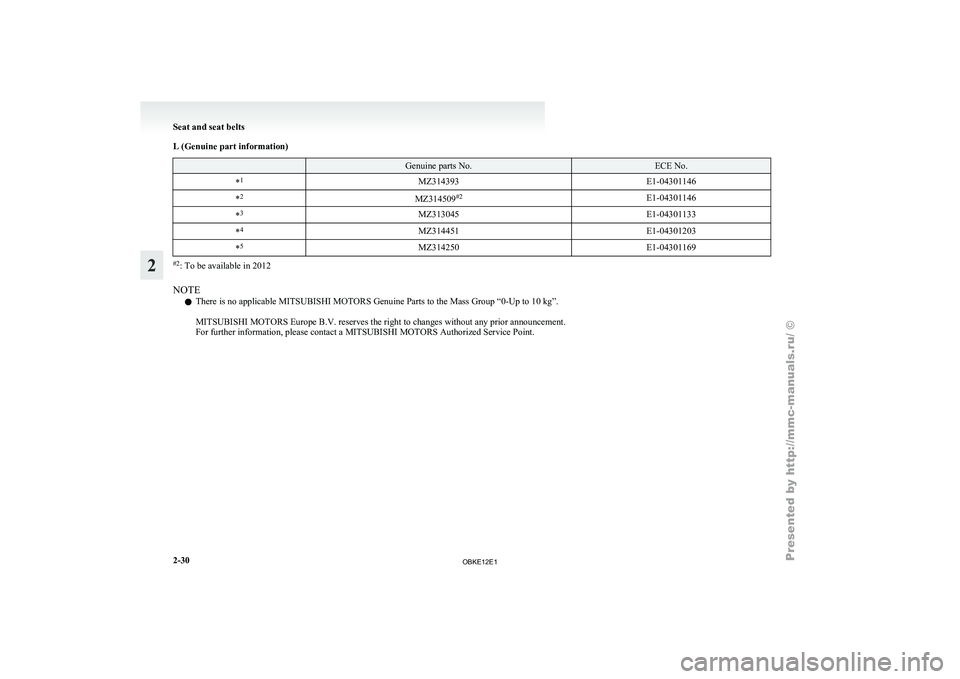
L (Genuine part information)
Genuine parts No. ECE No.
* 1
MZ314393 E1-04301146
* 2
MZ314509#2
E1-04301146
* 3
MZ313045 E1-04301133
* 4
MZ314451 E1-04301203
* 5
MZ314250 E1-04301169#2
: To be available in 2012
NOTE l There is no applicable
MITSUBISHI MOTORS Genuine Parts to the Mass Group “0-Up to 10 kg”.
MITSUBISHI MOTORS
Europe B.V. reserves the right to changes without any prior announcement.
For further information, please contact a MITSUBISHI MOTORS Authorized Service Point. Seat and seat belts
2-30
2
OBKE12E1
Page 68 of 377
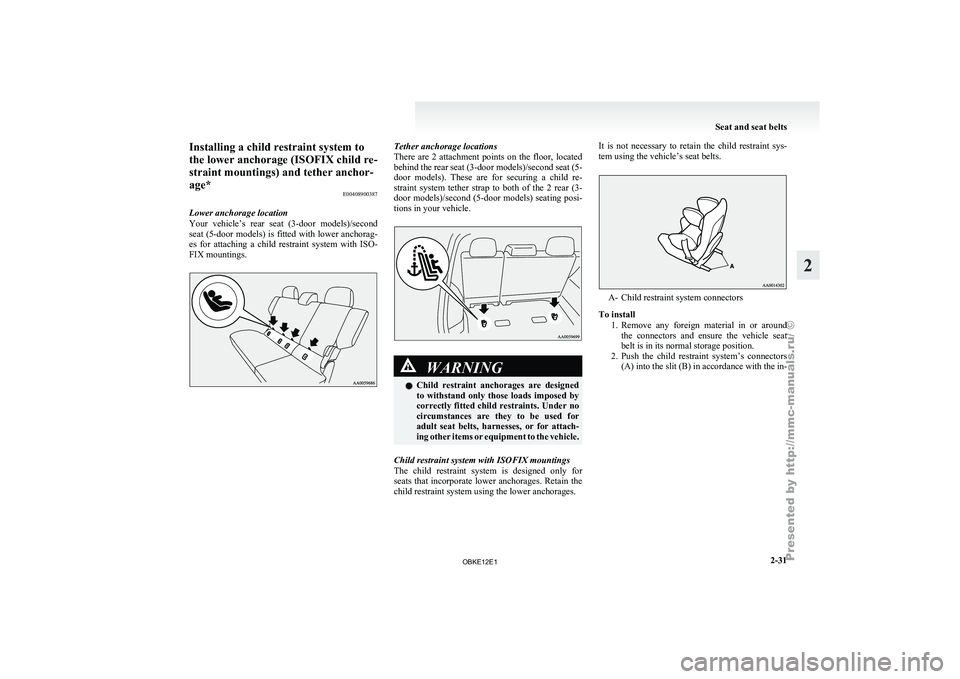
Installing a child restraint system to
the lower anchorage (ISOFIX child re-
straint mountings) and tether anchor-
age*
E00408900387
Lower anchorage location
Your vehicle’s rear
seat (3-door models)/second
seat (5-door models) is fitted with lower anchorag-
es for attaching a child restraint system with ISO-
FIX mountings. Tether anchorage locations
There are 2
attachment points on the floor, located
behind the rear seat (3-door models)/second seat (5-
door models). These are for securing a child re-
straint system tether strap to both of the 2 rear (3-
door models)/second (5-door models) seating posi-
tions in your vehicle. WARNING
l Child restraint
anchorages
are designed
to withstand only those loads imposed by
correctly fitted child restraints. Under no
circumstances are they to be used for
adult seat belts, harnesses, or for attach-
ing other items or equipment to the vehicle.
Child restraint system with ISOFIX mountings
The child restraint
system is designed only for
seats that incorporate lower anchorages. Retain the
child restraint system using the lower anchorages. It is not necessary to retain the child restraint sys-
tem using the vehicle’s seat belts.
A- Child restraint system connectors
To install 1. Remove any foreign
material in or around
the connectors and ensure the vehicle seat
belt is in its normal storage position.
2. Push the child restraint system’s connectors (A) into the slit (B) in accordance with the in- Seat and seat belts
2-31 2
OBKE12E1
Page 69 of 377
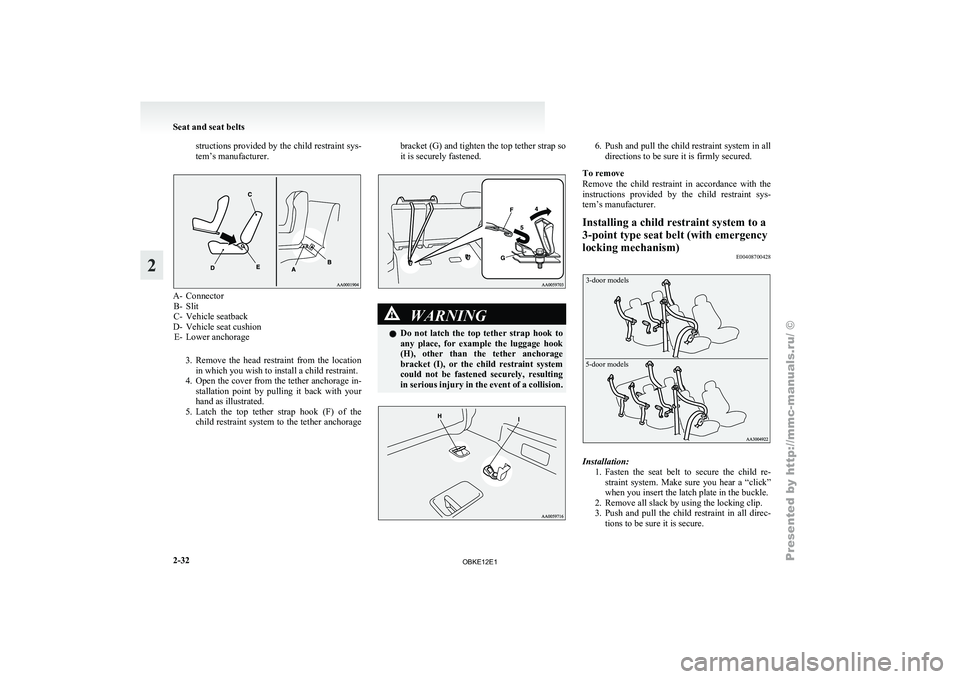
structions provided by the child restraint sys-
tem’s manufacturer.
A- Connector
B- Slit
C- Vehicle seatback
D-
Vehicle seat cushion
E- Lower anchorage
3. Remove the head restraint from the locationin which you wish to install a child restraint.
4. Open the cover from the tether anchorage in- stallation point by pulling it back with your
hand as illustrated.
5. Latch the top tether strap hook (F) of the child restraint system to the tether anchorage bracket (G) and tighten the top tether strap so
it is securely fastened.
WARNING
l Do not
latch
the top tether strap hook to
any place, for example the luggage hook
(H), other than the tether anchorage
bracket (I), or the child restraint system
could not be fastened securely, resulting
in serious injury in the event of a collision. 6. Push and pull the child restraint system in all
directions to be sure it is firmly secured.
To remove
Remove the
child restraint in accordance with the
instructions provided by the child restraint sys-
tem’s manufacturer.
Installing a child restraint system to a
3-point type seat belt (with emergency
locking mechanism) E00408700428
3-door models
5-door models Installation:
1. Fasten the seat
belt to secure the child re-
straint system. Make sure you hear a “click”
when you insert the latch plate in the buckle.
2. Remove all slack by using the locking clip.
3. Push and pull the child restraint in all direc- tions to be sure it is secure. Seat and seat belts
2-32
2
OBKE12E1
Page 70 of 377
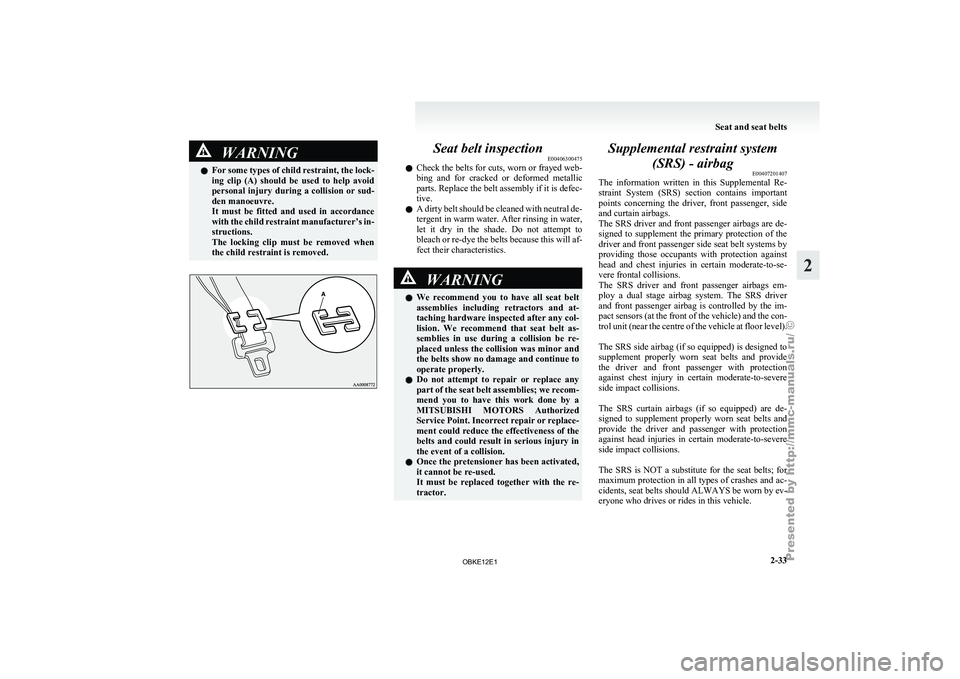
WARNING
l For some types of child restraint, the lock-
ing clip (A) should be used to help avoid
personal injury during a collision or sud-
den manoeuvre.
It must be fitted and used in accordance
with the child restraint manufacturer’s in-
structions.
The locking clip must be removed when
the child restraint is removed. Seat belt inspection
E00406300475
l Check the
belts
for cuts, worn or frayed web-
bing and for cracked or deformed metallic
parts. Replace the belt assembly if it is defec-
tive.
l A dirty belt should be cleaned with neutral de-
tergent in warm water. After rinsing in water,
let it dry in the shade. Do not attempt to
bleach or re-dye the belts because this will af-
fect their characteristics. WARNING
l We recommend
you
to have all seat belt
assemblies including retractors and at-
taching hardware inspected after any col-
lision. We recommend that seat belt as-
semblies in use during a collision be re-
placed unless the collision was minor and
the belts show no damage and continue to
operate properly.
l Do not attempt to repair or replace any
part of the seat belt assemblies; we recom-
mend you to have this work done by a
MITSUBISHI MOTORS Authorized
Service Point. Incorrect repair or replace-
ment could reduce the effectiveness of the
belts and could result in serious injury in
the event of a collision.
l Once the pretensioner has been activated,
it cannot be re-used.
It must be replaced together with the re-
tractor. Supplemental restraint system
(SRS) - airbag E00407201407
The information written
in this Supplemental Re-
straint System (SRS) section contains important
points concerning the driver, front passenger, side
and curtain airbags.
The SRS driver and front passenger airbags are de-
signed to supplement the primary protection of the
driver and front passenger side seat belt systems by
providing those occupants with protection against
head and chest injuries in certain moderate-to-se-
vere frontal collisions.
The SRS driver and front passenger airbags em-
ploy a dual stage airbag system. The SRS driver
and front passenger airbag is controlled by the im-
pact sensors (at the front of the vehicle) and the con-
trol unit (near the centre of the vehicle at floor level).
The SRS side airbag (if so equipped) is designed to
supplement properly worn seat belts and provide
the driver and front passenger with protection
against chest injury in certain moderate-to-severe
side impact collisions.
The SRS curtain airbags (if so equipped) are de-
signed to supplement properly worn seat belts and
provide the driver and passenger with protection
against head injuries in certain moderate-to-severe
side impact collisions.
The SRS is NOT a substitute for the seat belts; for
maximum protection in all types of crashes and ac-
cidents, seat belts should ALWAYS be worn by ev-
eryone who drives or rides in this vehicle. Seat and seat belts
2-33 2
OBKE12E1